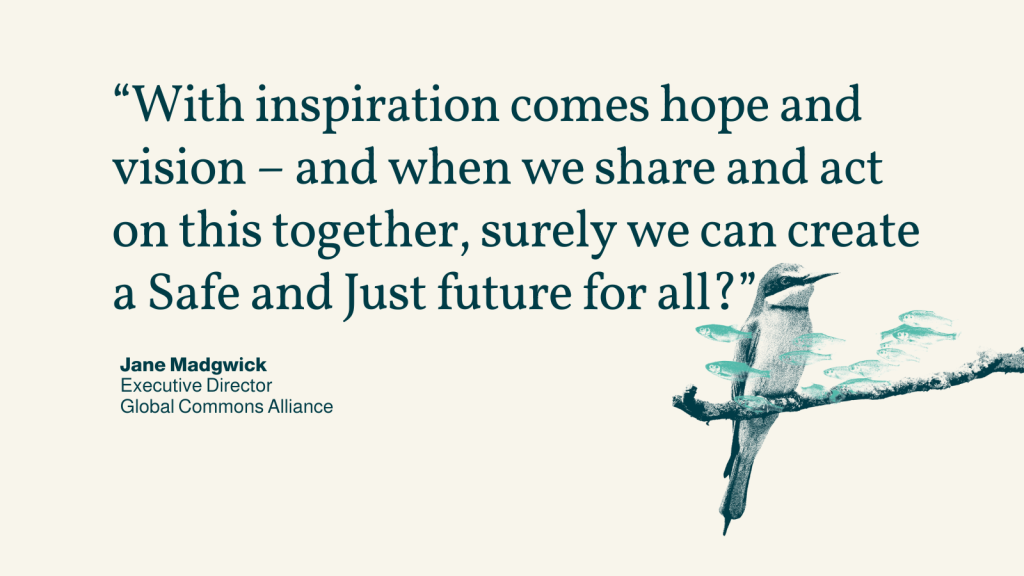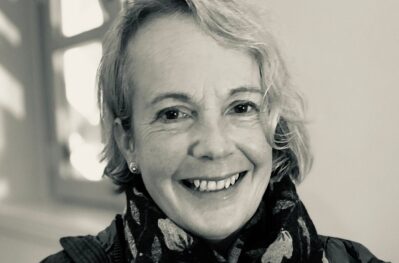Can we inspire each other and create the space for a safe and just future?
19/09/2024
A response to “A just world on a safe planet” Gupta et al, 2024, written by Jane Madgwick, Executive Director, Global Commons Alliance.
Hurrah for this publication and all the dialogues that will follow on. This science paper properly places humans as integral to the natural systems on Earth.
In the last decade, the realization that rapid changes to the fabric of our planet, such as the loss of Arctic ice and devastation of particular ecosystems, like the Amazon, can affect us all, has surfaced more. But global concern for nature and on climate change has not yet translated into effective coordinated action.
Now, as awareness and anxiety is growing due to our acceleration towards multiple planetary tipping points—past which no U-turn is possible—the new assessment from the Earth Commission sets out how we can address the drivers of that degradation and people’s vulnerability together.
The authors discuss why and how we need to bring together Earth’s limits for minimizing harm to people alongside the biophysical limits of planetary health in our governance, plans and actions.
They underline that people are less able to cope with some kinds of air and water pollution and climate change, than is the planet. And that people’s well-being depends on healthy nature, freshwater systems and oceans just as much as the planet does.
Healthy nature, healthy people
Of course this is not surprising, but the scientific rigour that confirms this result will help bust the myth that enhancing nature comes at the expense of human development and well-being. In fact, healthy nature is the essential basis for that.
As the authors point out, existing paradigms reflect a narrow view of progress and value systems that control investment choices, and largely ignore environmental, health and social risks and opportunities.
The overall narrative from this publication is positive: if we step up and work together in ways that reflect Earth’s limits in our economies, technologies and governance systems, it is entirely possible to return Earth to conditions that will underpin a safer, healthier and more just future for humanity.
Sounds good, doesn’t it? But what would that mean for different countries and societies, and what would our cities and landscapes look like if this were the case?
Now we have some global metrics which can be translated to different geographies and contexts. We are also starting to generate some specific science-informed visual images which give us enticing glimpses of the possible futures. But how hard is this journey? Where’s the catch?
Great transformations
Like all journeys, it starts with an intent on a direction and destination.
Consumers will need to choose to value nature, and be offered more affordable products that minimize harm to nature.
Business success will need to be based on value to society and nature’s contribution to society instead of only financial profits.
Cities will need to decide to evaluate how their production, consumption and trade footprints relate to their fair share of Earth’s natural resources and measures of justice.
Countries will all need to place the future of the Earth’s natural systems (the global commons) for common good, above that of nation states.
The transformations needed to reach the Safe and Just space will require nature’s resources to be shared more fairly and some reallocation of this “ecospace” to meet the minimum access needs of all. This will require considerable political attention and shifts in laws and governance, because while we do all depend on the global commons, the ownership and ability to exploit and manage these commons is not all common.

A mandate to act
Are we up for this? It’s important to note that we’re not starting from ground zero. While many actors are still sitting on the couch and will not get up until there are regulations that require them to do so, there is significant movement through leading cities, businesses and industry groups, indigenous and local communities and a growing number of multi-sector alliances.
There is also recent evidence that in G20 countries, there is high public demand for economic reform, including a wealth tax, to address inequality and prioritize investments in human health and the well-being of people and nature.
So there is a mandate for politicians to act. For those who have majored on addressing their climate footprint, and are aware but nervous of what it might involve to connect this with nature and social equity concerns, the scientific insights and the methods to translate the Safe and Just Boundaries for different actors and contexts, offer the opportunity to gain a holistic picture.
This new picture can drive a forward vision, reduce maladaptation risks and highlight win-win solutions, quantifying the implications of alternative development choices. It’s an essential compass that we need to learn how to use – before we stumble over a cliff edge.
Safe and Just space
As climate change and degradation of Earth’s natural system continues, we are getting better and better at monitoring shrinkage of the safe and just space. The “floor” of minimum access is rising due to increasing demand for resources, while at the same time the “ceiling” of what the Earth can cope with is lowering as resources and resilience are declining, due to disruption and degradation of the global commons. The authors warn that we have to act quickly while there is still some space left to crawl into!
The authors’ top recommendations for reaching the Safe and Just space are:
- to address inequality,
- enable better sharing of natural resources, and,
- shepherd more investment into sustainable technologies.
It could also be argued that investing heavily now in restoring nature and ecosystem functionality would be a smart and necessary priority alongside. Why? Because the main reason we are in this increasingly confined space is that we are taking out more from nature than it can continue to provide.
Sharing and restoring resources
If we restore nature and natural systems, taking into account interactions with socio-economic systems, more nature-benefits can be provided to people over the long term. Take freshwater as an example. We know that freshwater availability is declining in all regions of the world, causing water stress to be counted as one of the highest global risks to humanity, limiting food production, driving social conflicts and migration. We also know (from the Economic Commission on the Economics of Water, 2023) that this is caused largely by mismanagement of land and water resources, and to a lesser extent by climate change.
Sharing water resources (a global common good) better across society and improving its distribution through pipes, pumps, wells and irrigation technology can help more people only for a limited time, before the water sources run dry. But if we also act collectively to restore the deforested watersheds, mountain wetlands and river floodplains which capture, store, purify and distribute water, as well as enhance the “ sponge” capacity of cities, we can repair the hydrological system and ensure a sustainable supply of water for the long term.
Water allocation schemes that are guided by restoring and sustaining nature’s ability to supply water, and that share that water amongst users, will bring water security for all stakeholders, helping them ride out climate-driven water shocks. This example speaks to what seems to me a significant line in the paper: “ Accounting for interactions between ESBs could reshape the safe and just corridor considerably”.
Hope and vision
There are several global initiatives and partnerships that are promoting and quantifying success using “ whole landscape approaches” to bring returns for nature alongside societal and financial returns. The fourth and perhaps most vital return from holistic landscape solutions, promoted strongly by a leading organisation in this field, Commonland and its partners, is “Inspiration”.
With inspiration comes hope and vision – and when we share and act on this together, surely we can create a Safe and Just future for all?
- Read more about the new science
- Explore our latest Ipsos MORI survey
Stay up to date
2270
a:3:{s:5:”title”;s:27:”Subscribe to our newsletter”;s:3:”url”;s:45:”https://globalcommonsalliance.org/newsletter/”;s:6:”target”;s:0:””;}
a:2:{i:0;s:11:”a_wysiwyg_c”;i:1;s:5:”cta_c”;}
